new posts in all blogs
Viewing Blog: Writing for Children with Karen Cioffi, Most Recent at Top
Results 1 - 25 of 999

Writing tips, specifically for writing for children
Statistics for Writing for Children with Karen Cioffi
Number of Readers that added this blog to their MyJacketFlap: 9
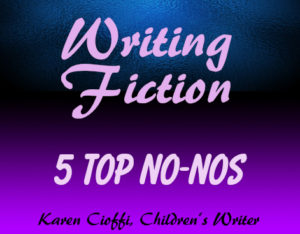 Fiction writers who are good at what they do, enjoy what they do. They like creating something from nothing . . . well from an idea. They enjoy the craft and the process.
Fiction writers who are good at what they do, enjoy what they do. They like creating something from nothing . . . well from an idea. They enjoy the craft and the process.
But, with that said, there are 4 top mistakes these writers make.
1. You make the beginning of your story all roses.
While we’d all love to live in a peaceful, happy land, readers need something to sink their teeth into, especially at the beginning of the story.
The beginning of your story is the hook. It’s where you GRAB the reader and make her have to turn the page and want to know what’s going to happen to the protagonist.
Here are a couple of examples of ‘hooking’ beginnings:
“I have noticed that teachers get exciting confused with boring a lot. But when my teacher said, ‘Class, we have an exciting project to talk about,’ I listened away.”
“The Talented Clementine” by Sara Pennypacker.
“My name is India Opal Buloni, and last summer my daddy, the preacher, sent me to the store for a box of macaroni-and-cheese, some white rice, and two tomatoes and I came back with a dog.”
“Because of Winn-Dixie” by Kate DiCamillo
These two examples of children’s writing give you a good idea of what it takes to ‘hook’ the reader.
2. The dialog is weak, fluffy.
Having weak dialog can kill your story. You need your characters to have passion . . . to have life.
You want dialog that is strong and tight. You want the emotion (the conflict, the tension, the passion) to come through the words. And, you want to say it in as few words and as realistically as possible.
You want the reader to feel what the character is feeling at that moment.
If Bob is angry in the story, show it through his dialog:
“WHAT! Who said you could take that?!”
“Hey! What are you doing?!”
“No! You can’t. Now get lost.”
“Get your hands off of me!”
The tight, strong dialog goes for exchanges also:
“Hey! What are you doing?!” Bob yelled.
Gia spun around. “Oh, ugh, nothing.” Her eyes darted to the door then back to Bob.
3. The story is predictable.
You’ve got to have some surprises in the story. If you don’t, it will make for a rather dull, predictable story.
For this aspect of your story, think questions.
– Why is the character in that situation?
– How did he get there?
– What must she be feeling, seeing?
– How can see get out of it?
– What might happen next?
Try to come up with four or five options as to what might happen next.
In an article at Writer’s Digest, the author advises to “Close your eyes and watch your scene unfold. Let the characters improvise. What are some outlandish things that could result? If something looks interesting, find a way to justify it.” (1)
Let your imagination run wild.
4. Your characters are one-dimensional.
For readers to become engaged in a story, they have to develop a connection with the protagonist and other characters. In order for this to happen, the characters must be multi-dimensional.
Characters need to be believable and unique. You don’t want them to be predictable or a stereotype.
According to “Breathing Life into Your Characters” by Rachel Ballon, Ph.D., “The essential components for creating successful characters with emotional and psychological depth—feelings, passion, desires, psychology, and vision—reside within [the writer].”
So, think about it. What conditions or characteristics does your character have?
– Does he have a personality disorder?
– Does he have phobias?
– Is she dysfunctional?
– Is she a troublemaker or bully?
– Is he anxious?
– Does she have an eating disorder?
– Is she fearful?
– Is she a risk taker, fearless?
And, keep in mind that the more stressful an ‘inciting incident’ or event, the more reaction and/or adjustment there will be.
For example: If a child lost a pet, it wouldn’t be as severe as losing a parent.
If a woman became separated from her husband, it wouldn’t be as severe as having her husband suddenly die.
So, using your experiences and innate characteristics, along with research, you can create multi-faceted characters.
5. You dump information into the story.
This is more of a mistake that new writers may make. I had a client who created the entire first paragraph of her middle-grade story with ‘information dump.’
She had the protagonist talking to a stuffed animal, in a pretend interview. She gave backstory and other details she wanted to convey to the reader through the interview. She didn’t realize that this information needed to be layered or weaved into the story, not dumped in one big truck load.
You might also use a prologue to give backstory.
While there are other things to watch for in fiction writing, these are five of the top no-nos.
Reference:
(1) 5 Biggest Fiction Writing Mistakes and Fixes
MORE ON WRITING FOR CHILDREN
Writing – 6 Essential Steps to Publication
Why Hiring a Ghostwriter for Your Children’s Book is a Good Idea
Submitting Queries – Be Specific and Professional
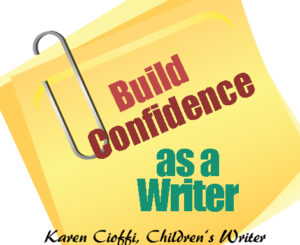 Guest post by Suzanne Lieurance
Guest post by Suzanne Lieurance
It’s tough being a writer, especially if you’re just starting out.
Rejection can easily tear down what little self-confidence you have, so here are a dozen ways to build your confidence as a writer:
1. Do Something First Thing Every Morning That Makes You Feel Good About Yourself.
It might even make you feel powerful. Go for a jog, do some exercises, take a shower and get dressed even if you won’t be leaving the house all day. Clean your office, put flowers on your desk. Do one small thing that celebrates YOU.
2. Expect to Be Successful.
Once you do, make sure that every thought, statement, and action reflects that expectation all day long.
Another thing to consider: What someone says about you can help you create a totally different and new expectation for yourself – so get a friend to write out a positive statement about you. Then notice how you strive to LIVE according to that statment every day.
Eliminate the self-doubt and negative thoughts in your head. Also, monitor the statements you make to others.
Avoid statements that begin with:
I can’t…
I don’t…
I’m stressed…
I’ll try, but….
I have to…
3. Focus on others instead of yourself.
As a writer, who is your reader? Who is your customer? How can you serve this customer and how can you get better and better at serving him?
When you’re out of the house, make a point to give a stranger or a friend or relative a compliment. Focus on them. Ask them about their day. When someone asks you how you are or are things are going, immediately say “GREAT” and believe it!
4. Don’t think about success too much.
If you do, you’re actually thinking about failure, not success. Failure is about doubt and worry and stress. Success is about letting go, going with the flow, feeling vibrant, excited, and full of energy.
When you expect success, you can begin to focus on the actions you must take rather than wallowing in self-doubt over the actions you have already taken. Just keep taking action.
5. Avoid living, thinking, and working in a panic mode.
This is when negative statements creep into your head and your language that do not serve you or others well.
6. Don’t compare yourself to others.
You are unique. It might take you 10 years to accomplish something someone else did in 2 years, but so what? Maybe you will learn so much more along the way than that other person did.
7. Realize that GOD, the universe (whatever it is you believe controls the world) wants each of us to succeed because when we succeed we serve the world in greater and deeper ways.
Faith is not so much about faith in God as it is faith in the divinity within you. Trust yourself to be able to handle anything you need to handle, to be able to do anything you need to do when, and if, you need to do it. But don’t spend time worrying or even thinking about this ahead of time.
8. Fake it till you make it.
Act confident even if you don’t really feel that way at first. Make it a game. But haven’t you ever noticed that the people who are truly the MOST confident are not arrogant? In fact, some of the most confident people are the most gentle people you will ever meet.
9. Don’t be ruled by your ego.
If someone does something you don’t like, or says something to you that you find insulting, practice relaxing and let it flow right through you.
10. At the end of each day, make a list of the things you did that day that you are proud of.
This could be simple things like folding the laundry, making dinner, or writing one scene of your novel.
11. Every morning, be grateful for another exciting day full of pleasant possibilities.
12. Be sure you hang around successful, positive people.
Use this list today to start building your confidence as a writer. You can do it. Try it!
For more writing tips and resources delivered to your e-mailbox every weekday morning, get your free subscription to The Morning Nudge from Suzanne Lieurance, the Working Writer’s Coach.
MORE ON WRITING FOR CHILDREN
Writing to Get Published – 5 Power Tips
Writing a Book – To Traditionally Publish or To Self-Publish
Writing, Submissions, and Working with Editors

Let me take a look at it. I’m a working children’s ghostwriter, rewriter, and editor. I can turn you story into a publishable and saleable book.
Shoot me an email at: [email protected] (please put Children’s Writing Help in the Subject line). Or, you can give me a call at 834—347—6700
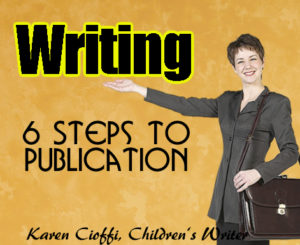 There are a number of articles and posts discussing whether it’s important to have a degree in writing in order to be successful in your writing career. The articles that I’ve read all agree that it is not necessary. But, there are at least 6 essential steps you will need to take to reach the golden ring of publication.
There are a number of articles and posts discussing whether it’s important to have a degree in writing in order to be successful in your writing career. The articles that I’ve read all agree that it is not necessary. But, there are at least 6 essential steps you will need to take to reach the golden ring of publication.
1. Learn the craft of writing
While it’s not essential to have a degree in writing, it is essential that you learn the craft.
You can obtain this knowledge through a number of avenues, such as:
a. Become a part of a coaching program or club. Just make sure the instructor or coach has the necessary credentials to teach or guide.
b. Research blogs and sites that offer instructional articles on the genre you are writing in. You can also find articles through the article directories.
c. Attend writing conferences. Even if you can’t go in person, or can’t afford to go, there are a number of free online conferences that offer great workshops, networking, and even pitches to publishers. One such conference is the Muse Online Writers Conference.
d. Join a critique group that has new and experienced writers. Critique groups are a great way to learn the ropes. The experienced writers will provide a kind of one-on-one tutoring. Through the critiques you receive you’ll begin to notice your common errors and how to correct them. Through the critiques you give, you’ll be able to pick up on errors much quicker. All this will help you to hone your craft and become a confident writer.
e. Read books about writing, self-editing, and books in the genre you are writing. Study these books.
2. Write and keep writing
Remember the old expression, ‘practice makes perfect.’ It’s important to make time to write every week, whether it’s daily or specific days, or even if you have to squeeze it into your schedule. The more you write, the more comfortable you will feel about writing.
3. Read your work, proofread your work, self-edit your work, revise your work…repeat
This is where you apply the information you’ve reaped from Step 1. After you think it’s ‘really’ good, submit it to your critique group. Then repeat Step 3. When you think it’s perfect you’re ready for Step 4.
4. Submit your work
In this step you can take two paths:
a. Submit your work to an experienced editor. This is the path almost all writers will advise you to take. The editor is trained to spot things that you and you’re critique group will not. Yes, it will be an expense, but there are some reasonable and experienced editors out there that you can take advantage of.
b. If you cannot afford an editor, be sure to carefully read a book about self-editing, print your manuscript out and go over it with a fine tooth comb. When you feel confident that it’s as good as you can get it, start submitting it to publishing companies and/or agents.
5. Read publishers’ guidelines carefully
Along with reading them carefully, you need to follow them carefully. Publishers have more submissions than they can handle, if your submission doesn’t meet their guidelines it would be highly unlikely it will avoid the trash pile.
6. Persevere
It’s not necessarily the best writer who gets published and has a successful writing career…it’s the writer who perseveres. Writing can be a long and arduous road and is usually filled with a great deal of rejection. But, if you work toward your goal, learn your craft, and keep moving forward, you have what it takes to become published.
MORE ON WRITING FOR CHILDREN
Why Hiring a Ghostwriter for Your Children’s Book is a Good Idea
Writing to Get Published – 5 Power Tips
Writing for Children – Character Believability and Conflict

Let me take a look at it. I’m a working children’s ghostwriter, rewriter, and editor. I can turn you story into a publishable and saleable book.
Shoot me an email at: [email protected] (please put Children’s Writing Help in the Subject line). Or, you can give me a call at 834—347—6700
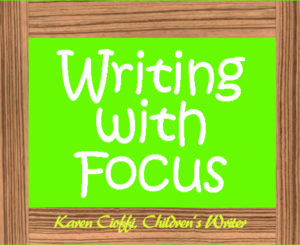 You have a wonderful idea for a story. Maybe it’s a mystery novel, a children’s middle grade story, or a picture book. Maybe it’s a young adult. You know what you want to say, or convey, and you start typing away. This is the beginning of every story.
You have a wonderful idea for a story. Maybe it’s a mystery novel, a children’s middle grade story, or a picture book. Maybe it’s a young adult. You know what you want to say, or convey, and you start typing away. This is the beginning of every story.
But, we should backtrack a moment and go back to the idea. The idea: your protagonist has a problem or conflict. Delving a little deeper, you can see how each chapter or section will be worked out.
You are sure you can bring your idea to full fruition—without the use of an outline. Okay, that’s fine. Many writers use the by-the-seat-of-your-pants (pantser) writing method. So, off your mind and fingers fly . . . creating something from nothing . . . well, not exactly from nothing, from an idea.
This is the beginning.
You type a draft of your story. How long this process will take depends on how long your manuscript will be—whether a novel, short story, or children’s story. Take note though . . . even if your story is as short as a children’s picture book, you still need focus in your writing.
Writing Focus
Focus is the path from point A to point B. It’s the path from beginning to end that keeps the story together and wraps it neatly up.
An example might be an ice skater whose goal is to become good enough to get into the Olympics. His focus will be to train vigorously to accomplish his goal.
Another example might be that of a school bus on its route to pick up children and bring them to school. The shop is where the bus begins, point A; it will end up at the school, point B. But, between point A and point B, the bus must deviate from the direct path to pick up each child.
The same holds true for your story. There is a path the story needs to follow to accomplish its goal. If you deviate too much from this path your story becomes diluted or weak. This is not to say you cannot have subplots, it means everything needs to be tied together moving forward on the same path toward the same end.
Using an outline can often help with maintaining focus, even with a short story. It’s kind of a writing GPS that guides you from point A to point B. It allows you to stray here and there with the comfort of knowing that you need to be at certain points throughout the manuscript. It’s a reminder to keep you focused.
MORE ON WRITING FOR CHILDREN
Writing to Get Published – 5 Power Tips
The Author Website – Keep It Simple and to the Point
Writing a Book – To Traditionally Publish or To Self-Publish
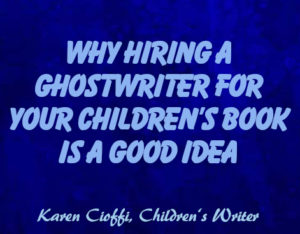 Why Hiring a Ghostwriter for Your Children’s Book is a Good Idea
Why Hiring a Ghostwriter for Your Children’s Book is a Good Idea
By Suzanne Lieurance, The Working Writer’s Coach
As the author of over 30 published books (most of them for children) and a former instructor for the Institute of Children’s Literature, where I taught a course in writing for children and teens for over 8 years, I’ve seen my share of awful children’s book manuscripts.
The thing is, so many people think that writing a children’s book is easy.
In fact, it’s so easy anyone can do it.
Well…that way of thinking is just plain wrong.
There are Distinct Guidelines to Follow
Children’s writing has some distinct guidelines and those guidelines should be followed whether you want to find a traditional publisher for your book or you
plan to self-publish it.
When you follow these guidelines, not only will you create a more marketable manuscript – meaning, a manuscript editors and other people who buy children’s books (teachers, librarians, parents, and grandparents) will be more likely to buy – you’ll also create a book that children are going to enjoy reading or enjoy listening to as someone reads the book to them.
This All Takes Time
It takes time to learn and understand these guidelines and even more time (and practice) learning how to apply them as you write for children.
For this reason, if you aren’t willing to invest in workshops or other training specifically about writing for children, and then spend months (possibly, even years) learning how to write for children with these guidelines in mind, then it’s probably a good idea to hire a ghostwriter to write your children’s book.
If you do, just be sure you hire a ghostwriter who specializes in writing for children.
Most writers who only write for adults don’t know or fully understand the elements needed in a marketable manuscript designed for the children’s book market, so while they may give you a manuscript that is well written, it still might not be very marketable.
A ghostwriter who specializes in writing for children, however, will create a marketable manuscript for the children’s book market.
One final word of warning here…
A ghostwriter who specializes in writing for children knows much more about this type of writing than you do.
While you don’t have to follow every suggestion of your ghostwriter, be sure you do follow the suggestions that adhere to the basic guidelines established for marketable children’s books.
Your ghostwriter will probably go over these guidelines with you, explaining them so you understand why and how suggested revisions to your manuscript (or your idea for a manuscript) need to be made.
Do yourself a favor and follow these suggestions and let your ghostwriter write a marketable manuscript for you.
For more writing tips and other resources for writers, get your free subscription to The Morning Nudge at www.morningnudge.com
MORE ON WRITING FOR CHILDREN
Being a Writer – Learn the Craft of Writing
Critiques are Essential for Writers
Finding Children’s Story Ideas
 Let me take a look at it. I’m a working children’s ghostwriter, rewriter, and editor. I can turn you story into a publishable and saleable book.
Let me take a look at it. I’m a working children’s ghostwriter, rewriter, and editor. I can turn you story into a publishable and saleable book.
Shoot me an email at: [email protected] (please put Children’s Writing Help in the Subject line). Or, you can give me a call at 834—347—6700
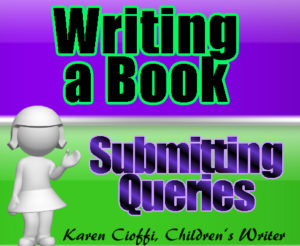 All writers face the dreaded query. Did I put enough information? Did I put too much? Did I have a great hook? Am I submitting to the right publisher or agent?
All writers face the dreaded query. Did I put enough information? Did I put too much? Did I have a great hook? Am I submitting to the right publisher or agent?
These are just a few questions that run through a writer’s mind when mailing or clicking the send button for the query. So, how do you answer these questions and the many others that go along with the job of crafting a query?
Well, the first simple response to this question is to READ the publisher’s or agent’s guidelines.
Okay, that’s not accurate-you need to STUDY and FOLLOW those guidelines precisely.
Items to watch for when reading those guidelines:
1. What genre does that particular publishing house, agent, or magazine publish?
2. Does the publisher/agent accept simultaneous submissions?
3. Is there a specific word count involved if querying for articles?
4. Does the publishing house accept unagented queries?
5. Does the magazine only accept specific themes, if so, is your article on target?
This list is not complete, there are obviously more items to watch out for. So, we go back to the main rule for querying: FOLLOW the GUIDELINES!
But, following the guidelines is just part of the querying process; you also need to know some inclusion essentials.
Six rules to use that will help you create a winning query:
1. Be professional. Writing is a business just like any other – it’s important to treat it as such.
2. Be sure to include your contact information: address, telephone number, email address and website.
3. If you were referred by someone, include it in the query. Every little bit helps, but be sure it’s a referral from someone the editor actually knows.
4. Write tight – be specific and jump right in. You want to provide enough information to motivate the editor to want more, but you need to keep it to one page.
5. The first paragraph is explaining that you’ve visited the company’s website and found they are accepting your genre. Or, you might simple state that you are submitting your manuscript for her review.
In this paragraph you can include the genre and the word count. And, it’d be a good idea to mention a published book that it might be similar to.
EXAMPLE:
Dear [Editor’s Name],
I’d like to introduce my 15,000 word fantasy chapter book, WALKING THROUGH WALLS, for your consideration. It is in the flavor of A SINGE SHARD by Linda Sue Park.
6. The second paragraph is the pitch. Within a couple of sentences you need to hook the editor or agent. Give a brief description of the story – just the essentials.
EXAMPLE of a first sentence for this paragraph:
In 16th century China, Wang works in the rice fields with his father, but this is not the life he wants.
In just one sentence, the time period is established along with the setting and conflict.
7. The third paragraph is about you. Again, keep it brief and include your credentials. Limit personal information unless it adds to your credentials as a writer qualified to write for this publisher or agent.
This is also the place you’ll briefly mention your marketing platform.
I had a client, who at the time she was querying agents, had around 45,000 Facebook followers and around 15,000 Instagram followers. She also had a website. These are things that are definitely worth mentioning!
Publishers and agents appreciate when authors already have an author platform up and running. In fact, if a contract is between ‘platformless’ you and another author who is equally qualified, but does have a platform in place, guess who’ll get that contract.
8. The fourth paragraph is your conclusion. Thank the editor/agent for his time and mention if you are enclosing a SASE (self-addressed and stamped envelope) and if the query is a simultaneous submission.
A good way to practice for queries and pitches is to write a one sentence ‘out of the ball park’ description of your manuscript. This will help you to think and write tight and choose the perfect words to hook the reader and convey the essence of your story.
MORE ON WRITING FOR CHILDREN
Self-Publishing: 3 Tips to Help You Avoid the ‘I Want It Now Syndrome’
Writing Rhyme in Children’s Stories
Is Your Manuscript Ready for Submission?

Let me take a look at it. I’m a working children’s ghostwriter, rewriter, and editor. I can turn you story into a publishable and saleable book.
Shoot me an email at: [email protected] (please put Children’s Writing Help in the Subject line). Or, you can give me a call at 834—347—6700
A version of this article was originally published by Karen Cioffi at:
http://EzineArticles.com/?id=3836899
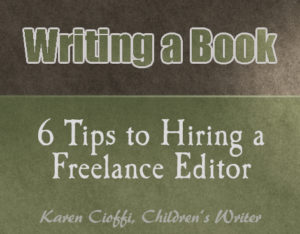 Will hiring a freelance editor ensure you pitch the perfect game? In writing terms, will it ensure you get published? Do you need an editor?
Will hiring a freelance editor ensure you pitch the perfect game? In writing terms, will it ensure you get published? Do you need an editor?
There are a number of pros and cons related to whether you should hire a freelance editor. Some writers benefit greatly from the experience while others have a difficult time and may even get insulted.
Six Points to Examine Before Hiring a Freelance Editor
1. Can you handle it?
One of the most important aspects of hiring someone to critique or edit your work is to be open to criticism. If you do not have the personality to handle constructive criticism, suggestions, and/or edits, then you shouldn’t hire a freelance editor.
2. Learn the craft.
Before you contemplate hiring a freelance editor, get your manuscript in the best shape possible by learning the writing craft.
What this means is you should know your craft or be engaged in learning it. You should obviously belong to a critique group that focuses on the genre you write. This group should have new and experienced/published authors in it. This will help you to hone your craft through the critiques you receive and the critiques you give.
There are also a number of fantastic free online writers’ conferences that will help you hone your craft. There are usually workshops offered covering just about every writing genre, plus freelance writing and marketing. AND, at some of them, you will have the opportunity to pitch to publishers. Between the networking and learning, it’s not something you should lightly pass on.
Next up on the road to learning your craft is to join a couple of writing groups – again be sure they have new and experienced writers. You can even look into a writing coach or instructor.
3. Self-edit, self-edit, self-edit.
Before you pass your manuscript off, be sure you’ve gone over it meticulously. Make sure you’ve gone over all the tips and tricks to have your manuscript in ‘good’ showing form.
Editors frown upon authors who send sloppy, error-filled manuscripts.
4. There are NO guarantees.
Hiring a freelance editor to go over your manuscript will not guarantee it will get published, even the best in the field can’t promise this. What they will do is help you to get it in the best shape possible. But, whether or not you take their advice is another story. And, again, even if you do, there are no guarantees.
This holds true everywhere in the writing world. After your manuscript is polished, you may send it to forty publishers and agents, and get forty rejections. Then, you send it to one more and it happens, this publisher was looking for just what you’re offering. They were looking for your story. Time and chance, my friends . . . and more importantly, perseverance.
But, it’s a sure bet if you’re manuscript isn’t polished you won’t ever get that far.
5. Ask around.
If you did your best to get your manuscript into what you think is publishable shape and you
want an editor to give it a final once over, be sure to ask for recommendations from other writers.
6. It ain’t over till it’s over.
Although you may spend money to get your manuscript edited before submitting it to publishers or agents, once it’s given a contract, it’ll be back to editing again – this time with the agency or publishing house.
Keep this in mind, so when it happens you’re not taken aback. It’s just the way it works.
MORE ON WRITING FOR CHILDREN
Writing a Book – To Traditionally Publish or To Self-Publish
The Writing Elements Mix – Is There a Right Balance?
How Do You Build a Successful Writing Career? (3 Tips)

Let me take a look at it. I’m a working children’s ghostwriter, rewriter, and editor. I can turn your story into a publishable and saleable book – into a book you’ll be proud of.
Shoot me an email at: [email protected] (please put Children’s Writing Help in the Subject line). Or, you can give me a call at 834—347—6700
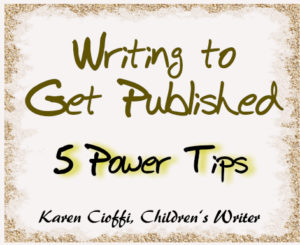 All writers have one primary focus—to get published. What makes each of us different is our slant or perspective on the story we’re telling, and how we tell it.
All writers have one primary focus—to get published. What makes each of us different is our slant or perspective on the story we’re telling, and how we tell it.
It’s true that anyone can write, but writing to get published is another story. To accomplish this, there four steps you need to include in your writing. (The fifth tips is a bonus.)
THE FIVE TIPS
1. Write an out-of-the-ballpark beginning
This is the crucial step that will determine whether the agent or editor keeps reading. Your beginning needs to grab the reader; it needs to lead the reader on without him having to think about it.
Here are different slants on a possible beginning:
A. Jan saw blood dripping down the wall. She screamed.
This idea is a beginning that might entice a reader to read on, but the problem is it’s telling not showing. To add showing:
B. Blood dripped down the stark white wall, adding to the puddle already formed on the floor. Jane felt a quiver run down her spine. Reacting before thinking of the consequences, a blood curdling scream issued from the depths of her being.
C. Blood slowly dripped down the stark white wall. A quiver ran throughout Jane’s body. An urgent eruption welled up from the depths of her being and brought forth a blood curdling scream.
D. Blood slowly dripped down the stark white wall, adding to the dark red puddle already formed on the floor. A quiver ran throughout Jane’s body creating an urgent eruption that welled up from the depths of her being—a blood curdling scream issued forth.
Examples B, C and D do a much better job of showing rather than telling. While they can easily be taken apart and reworded for tightness, more description or less description, whatever the author deems necessary, for this article they serve their purpose.
And remember, using descriptive words and adverbs adds to the word count. So, analyze each word you use; be sure they enhance the story and move it along, not weigh it down. In today’s writing world publishers and agents want tight writing.
2. The body of your story
This area needs to fulfill the beginning’s promise. It needs to keep the reader interested in the characters and plot—this will ensure the reader keeps turning the pages. You also need to keep track of everything going on in the story and follow through. Readers don’t want to feel cheated or disappointed.
Some authors use character and event cards or sheets to keep track of each character’s qualities and the details to each event. This will guarantee continuity and help prevent loose ends.
3. Your ending
The ending must tie everything together and tie-up all loose ends. If you wrote a paragraph or chapter about John and Jane contemplating marriage then segue into something else, let the reader know how it ends up.
It’s also a plus if you can come up with a twist at the end, something the reader won’t expect.
But, keep in mind it’s essential that you leave the reader satisfied.
4. Submitting your work
You’ll never know if you’ve written the next best seller if you don’t submit your work. Research publishers and/or agents who work in the genre you write. Choose the ones that you think are the best fit and study their guidelines. Then, follow the guidelines and submit your work. Don’t let fear or uncertainty keep you from moving forward—nothing ventured, nothing gained.
5. Attend conferences.
If you’re able to, attend writing / pitching conferences, like the one Writer’s Digest has. I know an author who got nibbles from 10 out of 14 agents and publishers. Big enough nibbles that they requested 25-50 pages of her story. And, one requested the entire manuscript.
This is the power of pitching at a conference.
Along with this, it’s important to network as much as you can – conferences are a great place to do this.
MORE ON WRITING FOR CHILDREN
Writing with Clarity
Writing Rhyme in Children’s Stories
The Writing Elements Mix – Is There a Right Balance?
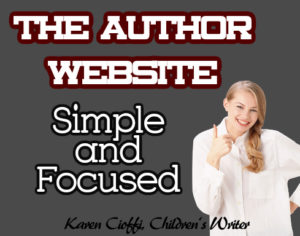 As an instructor of online classes that teach how to create and build an author online presence, of all the lessons, the most popular one, and the one that sparks the most questions, is how to create an effective author website.
As an instructor of online classes that teach how to create and build an author online presence, of all the lessons, the most popular one, and the one that sparks the most questions, is how to create an effective author website.
While some marketers still lean toward the effectiveness of long copy, especially for sales pages, some heavy hitters like Mike Volpe of Hubspot.com say, simple works best. And, as time passes, this ‘simple’ strategy is gaining more and more ground.
Why is this so?
The answer is time.
Have you landed on pages, especially sales pages that go on, and on, and on? I have and it’s actually kind of annoys me. If it’s a product I’m interested in I’ll scroll down, skimming, looking for highlights and the price in particular.
Have you scrolled down these pages and not been able to find the price?
As crazy as it sounds, there are landing pages out there that you have to click on the BUY button to find out how much the product you’re interested in costs. This takes additional time. And, it makes the potential customers feel like she has to jump through hoops to get the product.
You and everyone else are strapped for time today. We live in a faster and faster and faster world, a world that never sleeps. This causes us to work more and more and at a faster and faster pace.
According to the latest statistics, you have around FIVE seconds to grab a visitor, to convince or motivate him to pause long enough to move past the title and read your first and, hopefully, your second paragraph.
Time matters. Give the reader what she wants up front. And, what does she want?
The visitor to your site wants to know who you are and what you have to offer. Again, give the reader what she wants.
Keep your site simple, easy to read, and with a clear and simple call- to-action. And, if you have a product or service for sale, make the cost visible. Don’t make your landing page a Hide and Seek game. The visitor won’t appreciate it.
Okay, now that that you have the reasons for keeping your site simple and your call-to-action simple, here is one reason marketers may use the Hide and Seek strategy.
There is a marketing philosophy that uses a succession of Yeses to trigger the mind of the potential client or customer. It’s to motivate him, to say YES to the offer. According to pro marketer Clay Collins, this is considered ‘micro commitments’ or the YES ladder. Each time the visitor responds to the request, the conversion possibility increases.
While this might be a useful strategy for high-end products, for lower-end products, like your books or products under $50, this strategy could back-fire, especially with time factored in the equation. It’s not a good thing to make visitors jump through hoops to get the information they need.
So, bottom-line, keep your author website simple and to the point.
MORE ON WRITING FOR CHILDREN
How Do You Build a Successful Writing Career? (3 Tips)
Ingredients for a Perfect Picture Book
Writing a Book – To Traditionally Publish or To Self-Publish

Let me take a look at it. I’m a working children’s ghostwriter, rewriter, and editor. I can turn you story into a publishable and saleable book.
Shoot me an email at: [email protected] (please put Children’s Writing Help in the Subject line). Or, you can give me a call at 834—347—6700
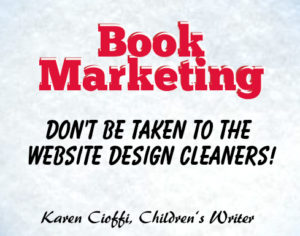 5 Tips on Creating an Author Website as the First Step in Your Online Marketing Strategy
5 Tips on Creating an Author Website as the First Step in Your Online Marketing Strategy
There is an abundance of website design and hosting services on the internet. You can get services that handle both the design and the hosting, or services that provide one or the other. Whatever your needs, there is a service out there for you.
But . . . consumer beware.
Some design/ hosting website services prey on unsuspecting and naïve authors or individuals and charge to not only create a site, but they keep control of managing the site. The customer is only allowed to add or edit content on the site.
This means the author can’t add links, change images, or tweak the site for SEO optimization, such as page title optimization. I get upset when I hear of occurrences like this. There is no reason why a design and hosting service needs to control website functions and features to the point that an author or individual needs to pay the service to add or delete a simple link.
Authors need to be aware.
This just happened to a client of mine who hired a website design company for her author site. She didn’t realize the company is simply a middle-man for a design company subcontracted to actually do the work. And, there is also a subcontracted content writer to write the webpage copy.
Do you see the costs rising and rising?
If this isn’t bad enough, the process is like the Abbott and Costello’s “Who’s on first. What’s on second” routine. For even the simplest of changes to the site, it has to go through the middle-man to the subcontractor for anything to get done. And, it can take weeks!
This is just mind-boggling. What a waste of money and time.
What’s an author to do?
There is so much information online advising on the basic dos and don’ts of creating a website, but you do need to do a bit of research to find it. And, there are plenty of legitimate and reasonable services out there. If you’re confused or uncertain, ask around.
Here are 5 starting tips to create an author website:
1. Choose an effective domain name. Think about it carefully. You want a name that will be search engine effective, reflect what the site is about, and is able to grow with you (unless you are creating the site for a specific book, service, or product). You can also use the title and subtitle to elaborate on the domain name.
2. Decide if you have the skills, or want to learn them, to create a website of your own. It can be pretty simple. You can check out Create Your WordPress Website Today (no code, no technical stuff, no fuss). It’s an interactive 5-day eclass through WOW! Women on Writing with lots of hand-holding and video instruction.
3. If you decide you want to hire someone to create the website for you, look for someone:
– Who wants to establish themselves as a website creator
– Who does it in her spare time
– Who has a writing/marketing service and does it more as a courtesy to clients
You will pay much, much less. And, try to make arrangements that will include the designer teach you how to manage your own site. This will make updates, changes, and posting much easier, and cost free.
4. If you feel you can create your own, you can choose a free hosting site, such as WordPress, Weebly, or Blogger. On the flip side, if the thought of having to create a website feels daunting, go for Blogger.com; it’s very user friendly and good for beginners. And with its updates, it has a number of features much like other websites.
Hot Tip: If you’re serious about marketing you, your books, and/or your services, go for a paid-hosting site.
5. Keep in mind that down the road you may want to have a website that can be effectively optimized and that’s more SEO versatile, and one that you actually OWN.
For these reasons, you should have a paid WordPress site from the beginning. The prices range from around $4 to $12 per month – depending on how long you sign up for. And, they have occasional specials where you can sign up for as low as $3.95 per month for a 36 month plan.
I use Bluehost for my sites and love it. I’m also an affiliate for them. You can get your own website and hosting through them too!
These five tips are the starting point for your author website and will hopefully help you from being taken to the website design cleaners.
MORE ON WRITING FOR CHILDREN
What Makes a Good Story? Plot Driven vs. Character Driven
Submitting Your Manuscript – 8 Tips
Book Marketing – You’ve Gotta Have a Blog
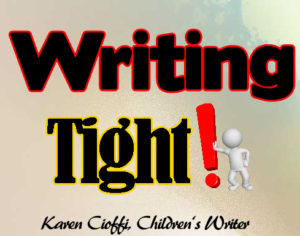 Guest Post by Penny Lockwood (Ehrenkranz)
Guest Post by Penny Lockwood (Ehrenkranz)
If you check market resources both for printed and on-line publications [picture books], you’ll find a number whose word limit is below 1,000 words. How do you trim the fat from your manuscript to fit within the tight confines of those word limits?
First, check your manuscript for “weak” modifiers. These are the words which writers hoping to strengthen another word. The two most commonly used words are “very” and “really.” Removing these words from your sentences will give them more impact.
Other weak, modifying words to watch for are: some, just, so, such, even, certainly, definitely, exactly, and that (when overused).
Second, check your manuscript for “wishy-washy” words. You’ll recognize them by their lack of clear definition. Words which fall into this category are: somewhat, sort of, rather, a little, perhaps, seem, and words with “ish” on the end, such as “shortish,” “tallish,” and “brownish.”
In an effort to create realistic dialogue, some writers insert “well” and “oh” into their sentences. Be sure to eliminate these from your manuscript. If a writer were to capture true dialogue, there would be pages and pages of “um,” “uh,” “well,” and “er.” Fortunately, as writers, that’s not our job. We need to create an illusion of reality, not play back word-for-word a “real” conversation. An occasional spattering of the interjections “oh,” “well,” and “um,” is sufficient.
Although adjectives and adverbs have a clear place in our writing, there isn’t an adjective or adverb that can strengthen a weak noun or verb. If you’re looking for variety in your writing, use a thesaurus instead. Go through your manuscript and highlight where you’ve used these modifiers to fatten up and strengthen ineffective words. Go back to the highlighted areas and replace those weak words with strong, descriptive nouns and verbs.
It’s not easy to trim the fat whether eliminating those yummy chocolate truffles from our diets or cutting out the weak modifiers, “wishy-washy” words, extra “wells,” “ums,” “ers,” and “ohs” from our dialogues, and replacing adjectives and adverbs with strong nouns and verbs. But if we want our human body or our body of work to be fit and desirable, we must trim the fat to achieve tight, firm writing or a lean physique.
While working on my latest release Ghostly Visions, I had a lot of help from my editors in trimming back the “fat.” This middle grade novel is comprised of two books published as one: Ghost for Rent and Ghost for Lunch.
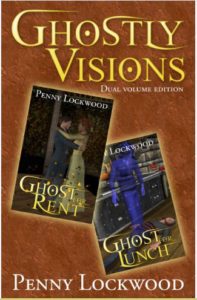
In Ghost for Rent, Wendy Wiles attracts ghosts when her parents separate and she, her brother, and mother move into a haunted house. The story begins in Portland, Oregon and quickly moves to small town, Scappoose, Oregon. Miserable at leaving her friends and beloved Portland behind, Wendy meets her neighbor Jennifer who tells her the house Wendy’s mom rented is haunted. After two of them appear to Wendy, the girls find themselves tracking down the mystery of who the ghosts are and why they “live” in the Wiles’ home.
In Ghost for Lunch, Wendy’s friend, Jennifer, moves away, leaving Wendy sad until new neighbors and their restaurant in St. Helens bring ghosts back into Wendy’s life. She, her brother, and their new friend discover the two cases are connected. Once again, the young sleuths use clues and lots of brainstorming to figure out who is haunting the restaurant.
While on the surface, these two stories appear to be about ghosts and the mystery of solving them, they are also about the importance of family and friends and working together to solve a problem.
Ghostly Visions is available direct from the publisher 4RV Publishing LLC for $15.99 including shipping and handling. It can also be ordered from your local bookstore with the following ISBN numbers: ISBN-10: 0982642326, ISBN-13: 978-0982642320, or through Amazon.
About the Author
 Penny Lockwood (Ehrenkranz) has published over 100 articles, 75 stories, a chapbook, and her stories have been included in two anthologies. She writes for both adults and children. Her fiction has appeared in numerous genre and children’s publications, and non fiction work has appeared in a variety of writing, parenting, and young adult print magazines and on line publications. She is a former editor for MuseItUp Publishing, 4RV Publishing, and Damnation Books. Visit her web site at http://pennylockwoodehrenkranz.yolasite.com and her writing blog at http://pennylockwoodehrenkranz.blogspot.com/.
Penny Lockwood (Ehrenkranz) has published over 100 articles, 75 stories, a chapbook, and her stories have been included in two anthologies. She writes for both adults and children. Her fiction has appeared in numerous genre and children’s publications, and non fiction work has appeared in a variety of writing, parenting, and young adult print magazines and on line publications. She is a former editor for MuseItUp Publishing, 4RV Publishing, and Damnation Books. Visit her web site at http://pennylockwoodehrenkranz.yolasite.com and her writing blog at http://pennylockwoodehrenkranz.blogspot.com/.
4RV Publishing has joined her two middle grade novels (Ghost for Rent and Ghost for Lunch) as Ghostly Visions. She recently released Boo’s Bad Day with 4RV Publishing and has one other children’s picture book under contract with them: Many Colored Coats. She has three romances published by MuseItUp Publishing: Love Delivery, Lady in Waiting, and Mirror, Mirror. Her short story collection, A Past and A Future, is available through Alban Lake Publishing and Smashwords.
MORE ON WRITING FOR CHILDREN
How Do You Make a Good Story Worthy of Getting Past the Gatekeeper?
Focus, Determination, and Perseverance = Writing Success
Writing a Fiction Story – Walking Through Walls Backstory
Most business owners have some kind of social media marketing in place. This is true for big business, small business, and home businesses.
But, if you haven’t really gotten your foot in the door, below are five steps to get an audience going.
1. Open an account in social networks you think will work well with your business.
There are lots of networks to choose from. A couple of the biggies
Images really do work. Studies prove that they boost social engagement.
I’ve been reluctant in this area.
There’s Facebook and Pinterest, and even Google+ that have lots of images. I hoped Twitter would remain image free. That wish was short-lived as more and more images appeared in Twitter posts.
But, it’s more than a trend.
Tweets with images get more retweets, the golden marketing
Just a heads up: According to Norton.com community, hackers have created a vulnerability in the Adobe Flash Player. Symantec has confirmed its existence.
This vulnerability is considered critical in that attackers could take control of an affected computer remotely.
Because of this, it's essential that you have the latest version of the Flash Player. Unless users install the patch or upload
Marketing, including email marketing, is all about research and testing . . . and the offer.
Through research and experience, I’ve realized, and I’m sure lots of other marketers have also, that it’s getting more difficult to increase your mailing list. Thousands of marketers, if not more, are vying for the same prospect you are. So, you need an edge. You need something that will make that
Have you seen those tweets soliciting Twitter followers and retweets?
I sure have.
Buying Twitter followers is a No-No. It’s like buying a list of subscribers for your email list. It’s just unethical.
But, what about buying retweets?
I hadn’t even thought about this until I read an article at Devumi. (1) It listed the Pros and Cons of taking advantage of this strategy. And, they sell the
If you use social media networks to publish your content, you should realize that one title or headline won’t have the same click-power as others. And, even if it’s effective now, it doesn’t mean it’ll be click worthy a month or so down the road.
If you’ve read about writing effective titles, you know they need to almost instantly grab the reader. Along with that, it must have enough
There’s a commercial on TV that shows someone doing one sit up; someone eating one blueberry; and someone eating one piece of broccoli
The gist of the ad is that you can’t simply do just one of something to expect good health. Interestingly, I don’t remember what brand it was or what the marketer was trying to sell. But, that’s beside the point.
What I took away is it takes ‘more than one.’
Today’s writers are well aware of this concept of writing tight. This is applicable whether your write nonfiction or fiction. It’s all about writing lean and mean – make every word count. But, in copywriting this concept is even more important.
Copywriting is about using words strategically to motivate the reader to take the action you want.
In an article at AWAI (American Writers and
I read an interesting article at Larry Maguire’s blog. It’s about using links in your blog posts.
We all know that external links and deep links are important for SEO, but should there be a limit?
I’ve seen posts that have links (external and deep) in almost every other sentence.
But, is this type of 'link stuffing' helpful? And, what on earth is the purpose?
There are at least three
I’ll admit I hadn’t thought about Twitter backgrounds. I did have a Twitter header created, but again hadn’t given the background a second thought. Then I read an article at Devumi Blog.
Devumi explains that having a customized background does a number of things, including giving you another place to put your logo.
Other benefits include:
1. Brand uniformity, including your color scheme
2.
No matter what you're into, what niche or industry you're in, knowledge is power.
As content writing and marketing is in the turbulent marketing waters, I'm always reading, taking courses, and joining pros in their membership groups.
It's work, time consuming, and can be expensive.
But, what's the alternative?
As a business owner you MUST keep up with what's going on in your industry.
I’ve written about content curation before, telling how useful a marketing tool it is.
Well, it still is.
Generating content on a regular basis is a must. In fact, in a study on blogging frequency, it noted that businesses that posted 16+ articles per month had 4 ½ times more leads than businesses that posted under 4 times per month.
For smaller companies with 1-10 workers, posting 11+ times
You want to start a home or small business. Or, maybe you want to take an existing business to the next level.
But, but, but.
You’re just not sure you can. You think about and think about it.
Do you have the drive?
Do you have the money?
Do you the skills and/or knowledge?
Do you have a business plan?
The questions can go on and on.
You know what this is called, don't you?
Lately, I’ve seen a few ‘Miss You’ emails from marketers. These are from marketers whose emails I haven’t opened in a while or emails that I’ve opened, but haven’t clicked on any links.
Hey, I’m busy. I scan my emails and save lots and lots of them to read later. I often though don’t get the chance to go back and read them, because a new batch of emails arrives in my inbox the next day.
View Next 25 Posts
 Fiction writers who are good at what they do, enjoy what they do. They like creating something from nothing . . . well from an idea. They enjoy the craft and the process.
Fiction writers who are good at what they do, enjoy what they do. They like creating something from nothing . . . well from an idea. They enjoy the craft and the process.


 Guest post by Suzanne Lieurance
Guest post by Suzanne Lieurance
 There are a number of articles and posts discussing whether it’s important to have a degree in writing in order to be successful in your writing career. The articles that I’ve read all agree that it is not necessary. But, there are at least 6 essential steps you will need to take to reach the golden ring of publication.
There are a number of articles and posts discussing whether it’s important to have a degree in writing in order to be successful in your writing career. The articles that I’ve read all agree that it is not necessary. But, there are at least 6 essential steps you will need to take to reach the golden ring of publication. You have a wonderful idea for a story. Maybe it’s a mystery novel, a children’s middle grade story, or a picture book. Maybe it’s a young adult. You know what you want to say, or convey, and you start typing away. This is the beginning of every story.
You have a wonderful idea for a story. Maybe it’s a mystery novel, a children’s middle grade story, or a picture book. Maybe it’s a young adult. You know what you want to say, or convey, and you start typing away. This is the beginning of every story.
 All writers face the dreaded query. Did I put enough information? Did I put too much? Did I have a great hook? Am I submitting to the right publisher or agent?
All writers face the dreaded query. Did I put enough information? Did I put too much? Did I have a great hook? Am I submitting to the right publisher or agent? Will hiring a freelance editor ensure you pitch the perfect game? In writing terms, will it ensure you get published? Do you need an editor?
Will hiring a freelance editor ensure you pitch the perfect game? In writing terms, will it ensure you get published? Do you need an editor? All writers have one primary focus—to get published. What makes each of us different is our slant or perspective on the story we’re telling, and how we tell it.
All writers have one primary focus—to get published. What makes each of us different is our slant or perspective on the story we’re telling, and how we tell it. As an instructor of online classes that teach how to create and build an author online presence, of all the lessons, the most popular one, and the one that sparks the most questions, is how to create an effective author website.
As an instructor of online classes that teach how to create and build an author online presence, of all the lessons, the most popular one, and the one that sparks the most questions, is how to create an effective author website. 5 Tips on Creating an Author Website as the First Step in Your Online Marketing Strategy
5 Tips on Creating an Author Website as the First Step in Your Online Marketing Strategy Guest Post by Penny Lockwood (Ehrenkranz)
Guest Post by Penny Lockwood (Ehrenkranz)
 Penny Lockwood (Ehrenkranz) has published over 100 articles, 75 stories, a chapbook, and her stories have been included in two anthologies. She writes for both adults and children. Her fiction has appeared in numerous genre and children’s publications, and non fiction work has appeared in a variety of writing, parenting, and young adult print magazines and on line publications. She is a former editor for MuseItUp Publishing, 4RV Publishing, and Damnation Books. Visit her web site at
Penny Lockwood (Ehrenkranz) has published over 100 articles, 75 stories, a chapbook, and her stories have been included in two anthologies. She writes for both adults and children. Her fiction has appeared in numerous genre and children’s publications, and non fiction work has appeared in a variety of writing, parenting, and young adult print magazines and on line publications. She is a former editor for MuseItUp Publishing, 4RV Publishing, and Damnation Books. Visit her web site at